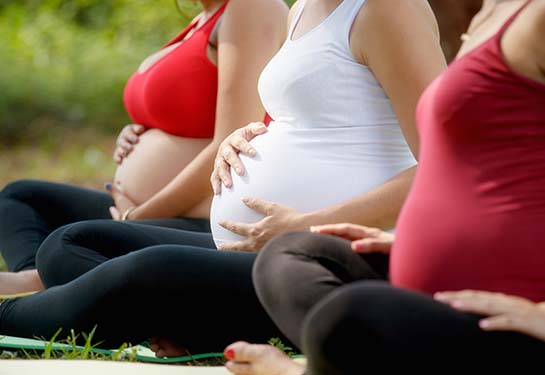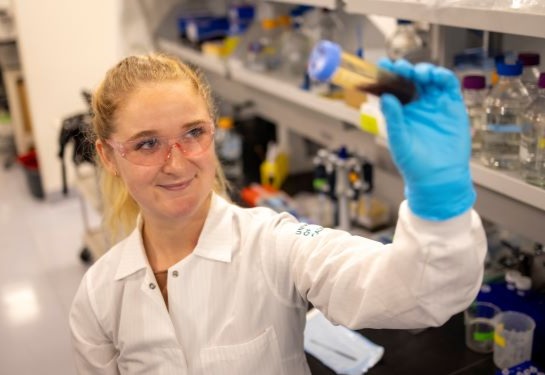Long-term national study of pregnant women finds increase in chemical exposure
Latinas had higher levels of many potentially dangerous chemicals
A national 12-year study that enrolled a highly diverse group of pregnant women, including women in the Sacramento region, found rising exposure to chemicals from plastics and pesticides that may be harmful to development.
“This is the first time we’ve been able to measure the amounts of chemicals in such a large and diverse group of pregnant women — not just identify chemicals,” said Tracey J. Woodruff, senior author of the paper. Woodruff is a professor and director of the UC San Francisco Program on Reproductive Health and the Environment and co-director of the UCSF EaRTH Center.
The results of the study, which included co-authors from UC Davis Health, were published May 10, 2022, in Environmental Science & Technology.
Prenatal exposure to industrial chemicals can come from air, food, water, plastics, and other industrial and consumer products. Although these chemicals could be harmful to pregnancy and child development, few of these chemicals are routinely monitored in people.
We know some of the chemicals cause harm, but for some of the ones being measured for the first time, all we can say with certainty is that exposure to these compounds is occurring."—Deborah Bennett
All participants had chemical exposure
To determine exposure, researchers measured 103 chemicals, mostly from pesticides, plastics, and “replacement chemicals,” new forms of chemicals that were banned or phased out, like bisphenol A (BPA) and phthalates. Certain phthalates have been identified as neurotoxic chemicals that can harm child brain development and increase children’s risks for learning, attention, and behavioral disorders.
All participants had chemical exposure, and several compounds were detected in all 171 participants. More than 80% of the chemicals were found in at least one of the women in the study, and more than a third of the chemicals were found in a majority of the participants. The study also found that some of these chemicals were present in higher amounts than seen in earlier studies.
The multi-institutional study included 171 women from California, Georgia, Illinois, New Hampshire, New York, and Puerto Rico who are part of the National Institutes of Health Environmental influences on Child Health Outcomes program. About one-third (34%) were white, 40% were Latina, 20% were Black, and the remaining 6% were from other or multiple groups.

Latinas had higher levels of exposure
The study found higher exposures for non-white women, those with lower educational attainment, or who were single or had been exposed to tobacco. Latinas had especially high levels of parabens, which are used as preservatives, as well as phthalates and bisphenols, which are used in plastics.
“While pesticides and replacement chemicals were prevalent in all women, we were surprised to find that Latinas had substantially higher levels of parabens, phthalates and bisphenols,” said Jessie Buckley, associate professor of environmental health and engineering, as well as of epidemiology, at Johns Hopkins Bloomberg School of Public Health and first author of the study.
“This could be the result of higher exposures to products with chemicals, such as processed foods or personal care products,” Buckley said. “Our findings make clear that the number and scope of chemicals in pregnant women are increasing during a very vulnerable time of development for both the pregnant person and the fetus.”
Many of the chemicals the women had been exposed to were replacement chemicals, which may turn out to be just as harmful as the ones they replaced. The study also found many women had been exposed to neonicotinoids, a widely used insecticide that is toxic to bees.
“Exposure to chemicals in the environment is inevitable because they are used widely. We know some of the chemicals cause harm, but for some of the ones being measured for the first time, all we can say with certainty is that exposure to these compounds is occurring. More work needs to be done to determine potential risks,” explained Deborah Bennett, a co-author of the study. Bennett is a professor of environmental health in the UC Davis School of Medicine Department of Public Health Sciences. She helped identify which chemicals to track.
“Exposures are generally low, so pregnant moms should continue to live their lives and not be too concerned,” Bennett said. According to Bennett, there are steps people can take to help limit chemical exposures.
“Cook at home using fresh or frozen ingredients — rather than processed or packaged foods — when possible,” Bennett said. She also recommends avoiding pesticides and controlling household pests without chemicals. “People can also learn which personal care products have fewer harmful chemicals by checking with organizations such as the Environmental Working Group.”
Many of the children in this study will be followed as part of the Environmental influences on NIH Child Health Outcomes (ECHO) program study.
Bennett is leading a separate study funded by the Environmental Protection Agency that is looking at children’s exposure to chemicals in household dust. Bennett and her team will track more than 80 chemicals in dust collected from participating homes, including many plasticizers, flame retardants and environmental phenols.





